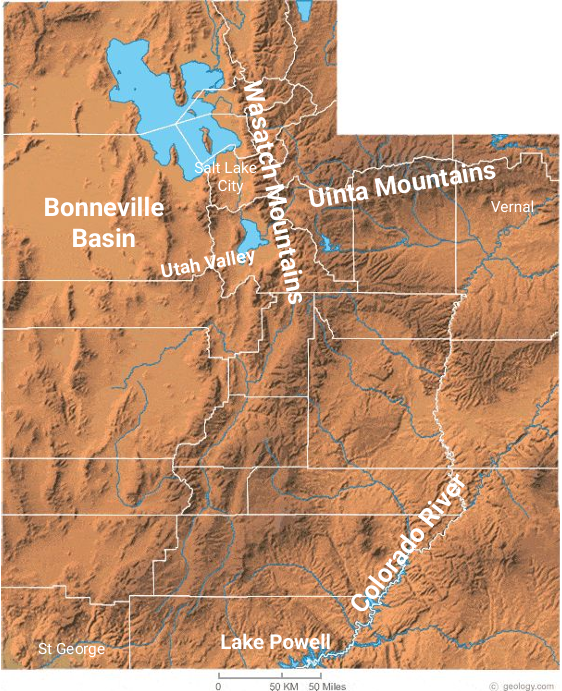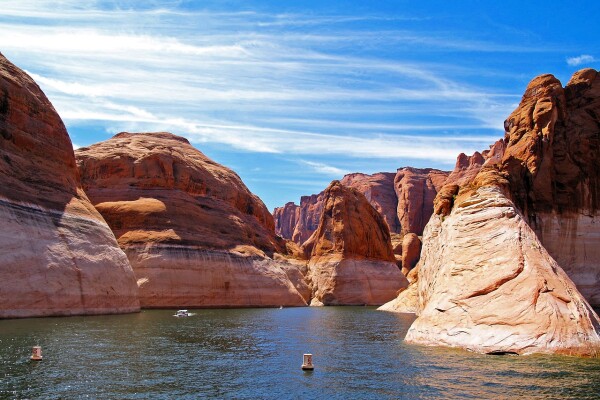Utah's Water Management
Central Question
Have Utah's water management projects been more beneficial or harmful in the long-term?
What should Utah do about water management to support its growing population?

Image courtesy of WaterHistory.org

Public Domain Image

Image courtesy of Brian Snyder, Reuters
Background Information
Utah is one of the driest states in the country. Because of that, water has always been a scarce resource for growing settlements here. When Brigham Young, President of the Church of Jesus Christ of Latter-day Saints, and the pioneer settlers who followed him (hereafter referred to as “Saints”) started irrigating crops in the late 1840s, it was the first large-scale irrigation project in the United States! Today Utah is still growing, and having enough water is still a concern. Below are some of the projects that Utah has used to address water needs in the past.
Vocabulary
Water rights: the legal right to access and use water from a particular water source.
Diversion: redirection of water from its natural flow.
Acre-foot: a unit for measuring water. The amount of water it would take to fill one acre of space a foot deep.
Basin (river drainage basin): The area drained by a river and its tributaries.
Water conservancy district: a government organization in charge of managing and conserving water within a region.
Sierra Club: a nonprofit environmentalist organization that has fought against several of Utah’s more environmentally-risky water projects.
Infrastructure: the physical and organizational structures that a society uses to function, such as roads, water pipelines, power plants, and buildings.

The Strawberry Valley Project
As early as the 1860s, settlers in the Utah Valley began diverting water from the Spanish Fork River for irrigation. However, the water supply was inconsistent, and it was not enough to support the area’s growing population. Utah settlers sought more land and water, often breaking their agreements with the Uintah Utes to graze animals and divert water from reservation land.
In 1900, Utah state senator Henry Gardner designed a plan to channel more water to the Utah Valley through the Wasatch Mountains. It included a new dam and reservoir (on reservation land), a tunnel under the Wasatch Divide to carry water into the Spanish Fork River, and several other small water diversion projects. It was authorized in 1905, and US Congress removed the land in question from the Uintah Reservation without consulting the Utes.

The 3.8 mile Strawberry tunnel under the mountains was finished in 1912, and the Strawberry Dam was finished the next year. It succeeded in bringing more water for farmers. By the 1980s, the project provided irrigation water for about 40,000 acres of land. Construction brought other benefits too. At first, the drills used to make the tunnel were so inefficient and expensive that construction paused. To power better and more affordable drills, hydroelectric power plants were built along the river. There are now three hydroelectric plants in the Spanish Fork area that use water from the Strawberry Valley project. To help transport workers and heavy equipment better, the area also got improved roads. The project allowed more people to move to the area and opened the way for other water projects in the future.
The Colorado River and the Central Utah Project
Utah continued to grow after the Strawberry Valley project, and so did other states in the dry West. In 1922, the seven states along the Colorado River formed the Colorado River Compact to divide up rights to the river’s water. The Colorado River’s flow is inconsistent, so it was important to store extra water during wetter years to have enough water for drier years. To do that, Congress passed the Colorado River Storage Project Act in 1956. The Act included four major reservoirs (Lake Powell, Flaming Gorge, Navajo, and Aspinall) along the river and 11 other projects that would allow states to access the river’s flow.

The Central Utah Project (CUP), Utah’s largest water endeavor ever, was one of those 11 projects. The original plan was very ambitious; it was designed to irrigate more than 400,000 acres of farmland and provide water for homes and businesses along the Wasatch Front. The most complex and controversial part was called the Bonneville Unit, which would gather water from twenty-three streams and rivers and send it through more than thirty miles of tunnels and pipelines to the Bonneville area. The plan included enlarging the Strawberry Reservoir, which would divert more water away from users in the Uintah Basin.
While many citizens in the Bonneville area supported the plan, many others thought it was too expensive and harmful to the environment. The Sierra Club fiercely argued against the unit. They said the project would disrupt mountain ecosystems, cost too much for taxpayers, and take water legally owned by the Ute Indian Nation. At the same time, Congress was trying to tighten its budget, and the CUP was expensive. For the CUP to survive, some serious changes had to be made.
The Central Utah Project Completion Act of 1992 found a compromise that satisfied most people. It promised restoration efforts to make up for the project’s environmental damage, gave responsibility to the Central Utah Water Conservancy District, and shrank the project to a more realistic size. However, it did not live up to the promises about access to water made to the Ute Indian Nation. The Bonneville Unit is still unfinished.
Glen Canyon Dam and Lake Powell
The Colorado River Storage Project also included the construction of Glen Canyon Dam in Arizona, which created Lake Powell on the Arizona-Utah border. Thousands of years before Glen Canyon became a reservoir, it was home to some of the Ancestral Pueblo people. Spaniards passed through the region in the late 1700s, and then the Saints came to the area in the mid-1800s. In 1869, John Wesley Powell led an expedition through the area and named it Glen Canyon. It was a beautiful place, and tourists and boy scouts floated the canyon river to see natural wonders like the Rainbow Bridge. The 1956 Colorado River Storage Act turned the canyon river stretch into Lake Powell.

Lake Powell is a big part of the Colorado River System; water from Lake Powell flows downstream to Lake Mead, and 40 million people in the Lower Basin states are affected by Lake Mead’s water storage. Lake Powell is also an important area for hydropower and recreation. Its hydropower reaches six states, including Utah, and the lake is one of the National Park Service’s most popular recreation areas. More than four million people visit Lake Powell each year.
Since about 2000, Lake Powell has been shrinking for many reasons. In its early years, Lower Basin states were not using as much of the dam system’s water as they are now. A years-long drought has added to the problem, along with rising temperatures in general. Wet years are increasingly rare, and when they come, they have not been enough to refill the Colorado River’s reservoirs. Hydropower, recreation, and the water systems downstream could all be impacted if Lake Powell’s levels continue to drop.
Utah Demographics and the Future of Utah Water
Utah’s population is still growing—and quickly. For the last decade, Utah has been the fastest-growing US state, and that growth is expected to continue for the next several decades. More than 2.2 million people are anticipated to move to Utah by the year 2060 as they are attracted to the state’s strong economy and good retirement locations. Utah county alone is predicted to double in population by 2060!
That population growth means that water management will continue to be very important to Utah’s future. Some claim that Utahns are already using too much water. Households are predicted to get smaller and closer together, which will help water resources stretch further. However, many say that this will not be enough to give people and businesses the water they will need. The Colorado River’s water levels are dangerously low already, and recent years have brought emergency conservation measures to Lake Powell and the Great Salt Lake. Diverting more water without compensating in some way would be difficult to justify.
The Utah Foundation, a nonprofit research organization, writes that when people are looking for more water, there are generally three methods they can use to get it: Conservation, conversion, and infrastructure. Conservation, the simplest way, means using less water in one place so more of it is saved for another. It can look like finding and choosing new ways to farm, landscape, or live that take less water. Conversion means purchasing water from someone else. Conversion could mean farmers buying water from an irrigation company or cities buying extra water from a neighboring town. Finally, governments can choose to add new water to a system through water infrastructure. The Strawberry Valley Project, the Central Utah Project, and the Lake Powell Pipeline (which would bring some of the lake’s water to the St. George area) are all large-scale examples of water infrastructure. Infrastructure can be very expensive, but helpful in the long run.
References and Additional Resources
Strawberry Valley:
The Strawberry Valley Project · Utah Stories from the Beehive Archive (utahhumanities.org)
strawberry.pdf (waterhistory.org)
Strawberry Valley Was Utah’s First Federal Reclamation Project | History to Go
Strawberry Valley Project (usbr.gov)
CUP:
https://www.utahhumanities.org/stories/items/show/416
Moving Mountains: Origins of the Central Utah Project · Utah Stories from the Beehive Archive (utahhumanities.org)
The Law of the River: The Central Utah Project - Utah State Archives and Records Service
Central Utah Project | History to Go
HistoryOfCentralUtahProjectFederalPerspective.pdf (riversimulator.org)
Lake Powell:
Lake Powell – Nature, Culture and History at the Grand Canyon (grcahistory.org)
The Lost Canyon Under Lake Powell | The New Yorker
The Story of Lake Powell - Western Resource Advocates
Demographics:
https://www.sltrib.com/news/2022/01/30/utah-years-million-strong/
Flowing into the Desert: A Background on Water in Utah - Utah Foundation
Utah Long-Term Planning Projections: A Baseline Scenario of Population and Employment Change in Utah and its Counties (d36oiwf74r1rap.cloudfront.net)
Author: Carley Garner, undergraduate student at Brigham Young University
Strawberry Valley Archive
"An Investment in Progress"
Hydroelectric Power in Spanish Fork
Uintah Indian Reservation
"A Gross Injustice"
Central Utah Project Archive
The Central Utah Project has a long and complicated history. Most of the sources below are about the Bonneville Unit (the most controversial part of the CUP).
CUP Economic Impacts
“Support Heavy at Hearing on Central Utah Project”
Sierra Club Comments
CUP Completion Act
Lake Powell Archive
“Lake Powell Will Be One of Nation's Tops for Tourists”
"Lake Powell's Future"
Glen Canyon Dam Hydropower
Quotes from Edward Abbey
Lake Powell Water Level Graphs
Utah's Water Future Archive
Governor Cox's Proposal
Slow the Flow
"Lake Powell Pipeline"
Washington County Water Conservancy District
“Utah’s Water Infrastructure”
“Climate change is shrinking the Colorado River”
This lesson can be adapted to fulfill either a Utah History Core Standard or a US History II Core Standard. Find the resources for both classes below.
7th Grade:
UT Standard 3.3: Students will describe the effects of events, movements, and innovations on Utah’s economic development, such as the organized labor movement, farming and industrial improvements, the World Wars, and the Great Depression.
UT Standard 4.5: Students will describe the historic and present management of natural resources and make recommendations for natural resource management in the future.
UT Standard 5.4: Students will use recent population growth and other demographic trends to make predictions about Utah’s growth, and create and defend a public policy in response to those trends.
8th Grade:
U.S. II Standard 8.2: Students will apply historical perspective and historical thinking skills to propose a viable solution to a pressing economic, environmental, or social issue, such as failing social security, economic inequalities, the national debt, oil dependence, water shortages, global climate change, pandemics, pollution, global terrorism, poverty, and immigration.


